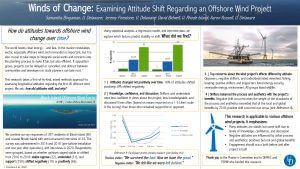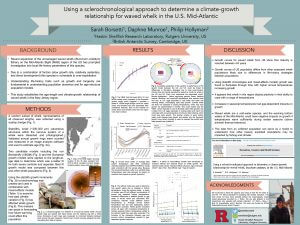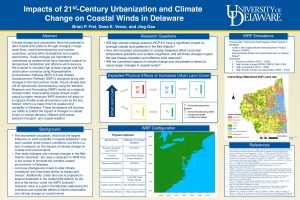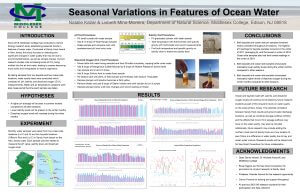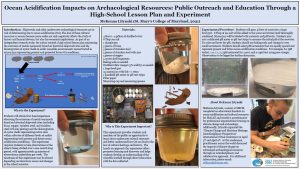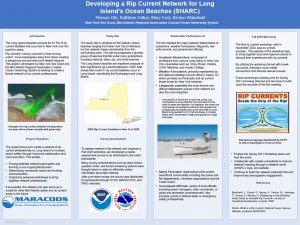2021 Mid-Atlantic Ocean Forum Poster Session
The Mid-Atlantic Committee on the Ocean (MACO) issued a call for abstracts from high school, undergraduate and graduate students and early career professionals for a virtual poster session at the Mid-Atlantic Ocean Forum. Poster abstracts were encouraged on topics relevant to ocean science, policy and socioeconomics in the Mid-Atlantic region from students and early career professionals within five years of graduation. Scroll below for video, abstracts, author information and posters from the session, held on May 5, 2021.
Session Video
Posters & Abstracts (Click images to view full size)
Winds of Change: Examining Attitudes Regarding an Offshore Wind Project
AUTHORS: Samantha Bingaman (Presenter), Dr. Jeremy Firestone, and Aaron Russell, University of Delaware; Dr. David Bidwell, University of Rhode Island
ABSTRACT: To enable effective marine planning, we must understand how communities react to marine renewable energies (MREs) and how these MREs interact with other ocean uses. With the Block Island Offshore Wind Project as our case study, we analyze how attitudes from 397 Block Islanders and coastal Rhode Island residents changed between the project’s pre-turbine installation and operation phases. Notably, we use a regression model and semi-structured interviews to focus on attitude changes regarding the project’s interaction with commercial fishing, tourism, energy transmission, boating, and marine wildlife; we also look at the influence of aesthetics, fairness of the planning process, and respondents’ awareness of climate change. Our results can be integrated into the marine planning process in the Mid-Atlantic to promote efficiency, equity, and the overall success of MREs when sharing space with myriad other ocean uses.
A Colossal Climate Change Challenge: Adapting to Protect the North Atlantic Right Whale in a Dynamic Marine Environment
Author: Aidan Bodeo-Lomicky, Monmouth University
ABSTRACT: The North Atlantic right whale, Eubalaena glacialis, is a critically endangered marine mammal native to the waters off the East Coast of North America. Fewer than 400 individuals remain, primarily due to fishing gear entanglement and vessel strikes. As climate change rapidly warms the right whale’s habitat, this species must venture into new, unprotected waters in search of food. This presentation will first discuss the threats to this species and how these threats are interconnected. It will then describe the applicable regulatory frameworks under the ESA and MMPA, examine how NOAA Fisheries is implementing the protections under these laws, and assess the weaknesses of this regulatory scheme. The presentation concludes by proposing adaptation measures to ensure the survival of this critically endangered species in the face of climate change, from short-term area closures to extended vessel speed restrictions and ropeless fishing gear requirements.
Using a Sclerochronological Approach to Determine a Climate-Growth Relationship for Waved Whelk, Buccinum Undatum, in the U.S. Mid-Atlantic
AUTHORS: Sarah Borsetti (Presenter) and Daphne Munroe, Rutgers University; Philip Hollyman, British Antarctic Survey
ABSTRACT: Using growth rings observed in statoliths, the size-at-age relationship was modeled for waved whelk (Buccinum undatum) populations within the Mid-Atlantic Bight. A total of 45 sites in the Mid-Atlantic were sampled between 2016-2019 using a scallop dredge, and a subset of the whelk collected were aged (n=318). Lab-reared individuals and back-calculation methods were used to fill missing juvenile observations. The Mid-Atlantic Bight population appears to differ in the fit of growth curves, compared to other assessed populations, due to a timing difference in hatching. Growth curves for whelk from the Mid-Atlantic Bight show that maturity is reached between 4 and 6 years of age. A statolith chronology spanning a 10-year period was developed using a mixed-effects modeling approach. The chronology was used to explore the influence of temperature variation on growth during ecologically relevant periods. Growth increased with higher annual temperatures however specific seasonal bottom temperature had varying effects on growth. Increasing bottom temperature during summer, the anticipated egg-development and hatching period in this region, resulted in an age-dependent decline in growth with a positive effect on younger whelk and a negative effect on older whelk growth. Higher summer temperatures provide larger time-windows for growth, facilitating increased growth in early life stages. It appears that whelk in this region possess sufficient growth plasticity to adapt to warmer conditions throughout the year, but increased warming during specific seasons may depress growth in older individuals, potentially affecting fitness and population persistence. Understanding these temperature-growth dynamics are critical for disentangling the effects of climate change on whelk growth, allowing for population predictions in the future.
Impacts of 21st-Century Urbanization and Climate Change on Coastal Winds in the Mid-Atlantic
AUTHORS: Brian Frei (Presenter), Dana Veron, and Jing Gao, University of Delaware
ABSTRACT: Climate change and urbanization have the potential to alter coastal wind patterns through changes in large-scale flows, local thermodynamics and surface roughness, among other atmospheric and oceanic phenomena. These changes are important to understand as coastal winds have important impacts on temperature moderation and offshore wind resource. We propose to simulate high climate change and high urbanization scenarios using Representative Concentration Pathway (RCP) 8.5 and Shared Socioeconomic Pathway (SSP) 5 scenarios. Future climate data will be dynamically downscaled by using the Weather Research and Forecasting (WRF) model as a regional climate model. Downscaling coarse climate model output to higher resolution WRF domains will allow us to capture smaller-scale phenomena such as sea breezes, which are a major driver of coastal wind variability in the coastal Mid-Atlantic. These simulations will improve our ability to predict the impact of changes in coastal winds on energy demand, offshore wind power, pollutant transport, and coastal weather.
Seasonal Variations in Features of Ocean Water at Sandy Hook
AUTHORS: Natalie Kazar (Presenter) and Lisbeth Mino-Moreira, Middlesex County College
ABSTRACT: Since 2016, Middlesex County College research students have conducted monthly water quality tests of ocean water in order to establish seasonal variations. Ocean and bayside water samples from four specific Sandy Hook beach locations on the coast of New Jersey were tested and measurements for salinity, dissolved oxygen, pH, and water temperature levels were recorded. Though remaining within ideal ranges, results showcase slightly lower pH averages each year for bayside samples, with elevated pH levels seen during the winter and summer. Ocean side samples also stayed within ideal ranges, showing the lowest averages in the summer and highest averages in the fall of 2020. Additionally, both bayside and ocean side location samples showcased noticeably lower salinity levels, and higher dissolved oxygen levels, during the winter months. The impact of Covid-19, as well as pollution from combined sewage overflows (CSO) is currently also being considered and investigated.
Ocean Acidification Impacts on Archaeological Resources: Public Outreach and Education Through a High-School Lesson Plan and Experiment
AUTHOR: McKenna Lynn Litynski, Mary’s College of Maryland
ABSTRACT: Shipwrecks and other underwater archaeological resources are at risk of deteriorating due to ocean acidification (OA). Shipwrecks serve as artificial reefs, nurseries for fish stocks, and play a role in heritage tourism. The loss of these cultural resources as oceans become more acidic not only negatively affects the study of history and human lifeways, but also has economic implications. This poster examines a high-school lesson plan concerning the corrosion of metals commonly found on historical shipwreck sites and the disintegration of oyster shells in acidic oceanlike environments reconstructed within mason jars representing both present and projected future OA conditions. This experiment provides an opportunity to learn about underwater cultural resources and better understand how OA can lead to the loss of cultural heritage and history. The hands-on approach can promote learning and discovery and help students develop an understanding of the scientific method through direct interaction with the data collected.
Developing a Rip Current Network for Long Island’s Ocean Beaches
AUTHORS: Pierson Ohr (Presenter), Cornell University; Kathleen Fallon, New York Sea Grant; Mary Ford and Kirstin Wakefield, Mid-Atlantic Regional Association Coastal Ocean Observing System
ABSTRACT: This project which is a collaboration between the New York Sea Grant (NYSG) and the Mid-Atlantic Regional Association Coastal Ocean Observing System (MARACOOS) is focused on creating a network of rip current professionals on Long Island to increase beach safety through improved collaboration and communication. This first entailed forming an initial participant list of relevant stakeholders, including but not limited to researchers, forecasters, lifeguards, and emergency management personnel across Long Island. A needs-assessment survey was then developed to gauge network interest and a workshop was held to bring the network together and allow for the facilitation of ideas. Additionally, after the success of the Fall 2020 workshop, future workshops such as in Spring 2021 are being planned. If successful, the network can also serve as a model for other Mid-Atlantic states and rip current areas in the future.

